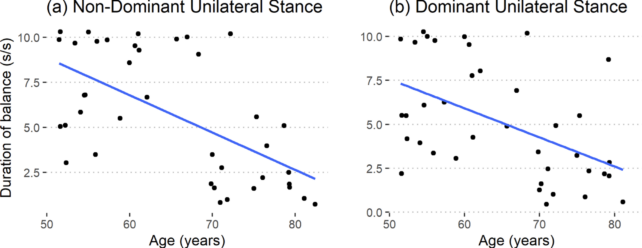ARTICLE AD
A healthy life is all about balance. If you're older than 50 and can stand on one leg for at least 30 seconds, scientists say you're aging really well, even if you sway from side to side.
A small new study has found evidence that as a person ages, their balance deteriorates faster than their muscle strength or their walking speed.
"To the best of our knowledge, such a comparison is the first of its kind within the elderly population," the team writes in their published paper.
"This study underscores the significance of the unipedal balance test in monitoring elderly subjects in the community, regardless of sex."
The authors, led by biomedical engineer Asghar Rezaei from the Mayo Clinic, hope their results can improve training programs for the elderly population, maintaining their physical independence for as long as possible.
A unipedal balance test is often used for older adults because balance is a known measure of neuromuscular aging.
A 1997 study, for instance, found those who are unable to balance on one leg for 5 seconds had over twice the risk of a future injurious fall, indicating their level of physical frailty. This type of test can also hint at neurological issues.
The new study investigates how long a person should be able to balance for, given their age.
Among a group of 40 healthy individuals, aged 50 and over, researchers found the length of time that a person could stand on their non-dominant leg fell by about 2.2 seconds a decade, regardless of their sex.
Time spent standing on the dominant leg, meanwhile, declined by 1.7 seconds per decade. When standing on one leg, the number of times a person swayed on the spot was not related to age.
While the cohort is small, this simple test of balance showed significant age-related declines – more so than measures of muscle strength, like grip, or the extension of the knee against resistance.
Gait speed, meanwhile, showed no significant changes across ages.
 Unipedal standing duration for the (a) non-dominant and (b) dominant sides. (Rezaei et al., PLOS One, 2024)
Unipedal standing duration for the (a) non-dominant and (b) dominant sides. (Rezaei et al., PLOS One, 2024)"This finding is significant because this [balance] measurement does not require specialized expertise, advanced tools, or techniques for measurement and interpretation," they add. "It can be easily performed, even by individuals themselves."
Each balance test conducted in the study went for 30 seconds. Participants were first asked to stand on both legs with eyes open and arms by their sides. Next, they did the same with their eyes closed.
Lifting up their dominant leg, participants then repeated the task for as long as they could, with eyes open and then closed. The non-dominant leg was also tested.
Participants stood on a plate that measured their center of pressure, so any subtle sways could be captured and analyzed.
"While all the subjects were easily able to maintain their balance during bilateral stance tests, our results showed that their [postural sway] movements increased significantly with age," the team writes.
When it came to one-legged standing, however, swaying was not a sign of age-related decline.
The findings suggest that swaying is a common part of standing on one leg, but when it occurs during two-legged standing, it might indicate a problem.
"Balance is an important measure because, in addition to muscle strength, it requires input from vision, the vestibular system, and the somatosensory systems," says biomedical engineer Kenton Kaufman from the Mayo Clinic.
"Changes in balance are noteworthy. If you have poor balance, you're at risk of falling, whether or not you're moving. Falls are a severe health risk with serious consequences."
The study was published in PLOS ONE.

 2 months ago
28
2 months ago
28 

